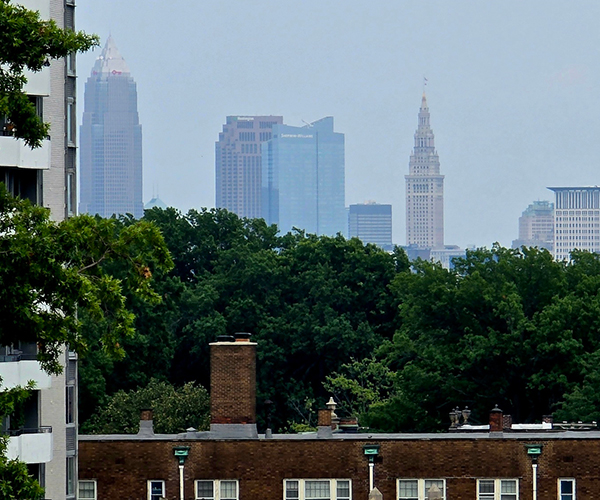Jessica Malone decided to stay. After a bachelor's degree from Case Western Reserve University and a master's from Cleveland State University, the 28-year-old Berea native chose to build a life here.
"Family is really important for me," she says. "So as long as my parents are going to be in the city of Berea, I didn't want to get too far."
But as she got older, it was community involvement — serving on nonprofit boards, mentoring through the Big Brothers Big Sisters program — that kept her here. "I'm plugged into so many different things going in, putting that time in, investing in it and you want to see the payoff."
She is not alone. A study, commissioned by the Cleveland Foundation in partnership with CSU and released in January, chronicles a class of Clevelanders that is profoundly impacting city life: the millennials. Nationally, they are 26.2 percent of the population. In Cleveland, 18- to 34-year-olds are 23.7 percent of the population.
Almost one in four Clevelanders is a millennial. You might think of them as downtown-dwelling, Platform Beer Co.-swilling, selfie-snapping young people. But there's more to them than meets the smartphone camera's eye.
Their arrival from locales as close as Berea to as far-flung as Beirut is a relatively new phenomenon. And they have the potential to change our city.
From 2000 to 2007, 9,842 millennials with a college degree fled Cleveland to greener pastures. But with the Great Recession, the pattern reversed. From 2008 to 2011, Cleveland gained 7,231 youngsters with degrees. And from 2011 to 2013 the region boomed, collecting another roughly 7,000 college-educated millennials.
"This is a movement of people, highly educated, largely white, that make high incomes moving within 3 miles of the urban core," says Richey Piiparinen, author of the study and director for the Center for Population Dynamics at Cleveland State University. "I don't think anything can stop it."
While overall, millennials are less likely than Gen Xers to live inside the city of Cleveland, according to the study, that's not the case when it comes to individuals with college degrees. Piiparinen's analysis shows that 16 percent of the region's college-educated millennials in the workforce now live inside Cleveland.
Urbanists have termed this influx the Fifth Migration.
Yet as college-educated young people move into the city center, less educated 25- to 34-year-olds are moving to the suburbs. This historic suburbanization, called the Fourth Migration, is ongoing.
Taken together, these two patterns present a historic migratory flip-flop — one that has the potential to redefine Northeast Ohio's urban and suburban landscape.
"I think the question is beyond: Are you guys going to keep coming?" says Lillian Kuri, program director for arts and urban design at the Cleveland Foundation who commissioned the study. "The question is: How to keep you guys, how to leverage it and make you part of a permanent strategy for cities and downtowns."
Drawn here by a low cost of living, family connections and the patina-crusted allure of Rust Belt chic, the millennials have arrived.
They are working in the HealthTech Corridor, drinking on West 25th Street and catching shows at the Beachland Ballroom and Tavern. They are tanning leather goods for sale at the Cleveland Flea. They are blocking the Shoreway to protest police brutality. They are writing and painting, cooking and tweeting.
They are here. So how do we make them stay?
To help answer that question and more, Cleveland Magazine surveyed more than 790 18- to 34-year-olds online from Feb. 3 through March 5 to understand their perceptions of the city, their reasons for being here and their hopes for its future.
For this brief moment, Cleveland is a stop of choice on the train of the millennial migration. College-educated young people, plugged into the globalized information economy, are sampling what Cleveland has to offer. And they are finding it to their liking.
Fifty-one percent of respondents to Cleveland Magazine's survey rated the city's food scene as "excellent" and another 74 percent called Cleveland's cultural attractions either "excellent" or "above average." But undeniably great amenities are not enough. For millennials to stay, Cleveland must be the preferred stop on the line.
To do that, affordable housing tops the list.
Overwhelmingly, college-educated millennials are living in Cleveland's rental havens — Ohio City, Tremont, downtown and University Circle. Outside the city, they are concentrated similarly in Coventry, Shaker Heights, Mayfield and Lakewood. Almost 54 percent of respondents to Cleveland Magazine's survey said they were renters.
For millennials, Cleveland is a bargain. But it appears such affordability will not remain forever.
Rents are creeping up, beginning in downtown. And developers remain hesitant to open lower-rent properties, which would serve millennials of all education and income levels.
"I've had at least three conversations with pretty young career professionals, early 20s, mid-20s, who have literally said, •I'm living with my parents until I can afford to move out. And when I can afford to move out, I have to go with a roommate because I can't do it on my own,' " says Ashley Basile Oeken, president of Engage Cleveland, a network of more than 80 young professional groups.
Higher rents, paired with limited inventory and small studio-style apartments on the low end, could push college-educated millennials back toward more cost-effective cities in the future.
"If there's no way to stay here and have an ownership stake here, they're going to go somewhere else," says Kuri, who is also a member of the Cleveland City Planning Commission.
Malone has lived on East Fourth Street for five years. For her first apartment, she paid $750 per month. "But now you can't get 700 square feet for that price," she says. "You're going to pay at least $1,000, likely more. I think that is making it harder for people to at least start down here."
Especially for millennials just entering the workforce, housing prices are a deciding factor in where to live, says Oeken. They are, in fact, more likely to find a place to live before finding a job.
Before rents climb too high, millennials should have options to own a home in the city, says Kuri. "One of the biggest opportunities for Cleveland because of the low cost of living is to have strategies for ownership," she says.
But right now, there are not enough homes in the city in good repair and within millennials' price ranges. Most are at the low or high price extremes.
High rents and few quality midlevel buying availabilities could, over time, encourage millennials to abandon Cleveland — either for the suburbs or for a cheaper city to rent in.
For Oeken, 30, buying a home in Olmsted Township was the cheapest long-term option. She wanted to live near the city, but the financial calculus was a simple one — and a half-hour drive to see her beloved Cleveland Cavaliers isn't too much of a drag.
"For what I paid to live in Olmsted Township," she says, "I could have gotten a shack in Lakewood."
Regardless of where they live, Cleveland millennials want to be close to work. Fifty-four percent of respondents to Cleveland Magazine's survey said that living close to the their workplace was either "very important" or "extremely important" to them.
For Malone, the assistant director for the Philanthropy Institute at the Cleveland Clinic, her quick commute from East Fourth to the Clinic is a plus.
But when they get to work, Cleveland millennials mirror their national kindred who say that they value a balance between work and play — 56 percent of respondents rated work-life balance as "extremely important." By contrast, only 28.5 percent said salary was "extremely important" to them.
"Sometimes, I think maybe I'm the odd duck, because advancement is important to me," says Malone. "But I also value being happy at my current place. Sometimes that gets pushed to the back burner, that your life can have value outside of this title and salary."
Despite that desire, millennials struggle to reach the higher rungs on Northeast Ohio's corporate ladder, says Oeken. When she came to Cleveland to work with the Fund for Our Economic Future, she was offered a full-time job after her two-year fellowship ended. She was quickly promoted, twice, until she thought she couldn't rise further with the company.
"So I ended up leaving," says Oeken. "I just felt like I was never going to get on that path to have true advancement opportunities, both in terms of title and in pay as well."
It is a struggle she sees often among those who attend Engage Cleveland's events, she says. In some industries, health care, for instance, there are entry-level job opportunities. But in Cleveland, millennials can only climb so far.
"A lot of people at my level have been leaving because of that ceiling issue. They don't want to sit and wait three, four, five years for the next promotion," says Malone. "They've gone to other nonprofits as a director or smaller nonprofits as executive director."
Yet one area in which there seems to be little shelling is within Cleveland's boardrooms. Millennials are often greeted with indifference, says Oeken, by Cleveland's network of nonprofit boards, government commissions and valuable relationships that often guide policymaking.
Such civic involvement could root young people in the Forest City for decades. For Malone, it was serving on the boards of the Case Western Reserve University Alumni Association and Malachi Center. For Oeken, it was her efforts on the board of the St. Luke's Foundation.
But for most Cleveland millennials, a generation that really wants to be involved, there aren't enough civic opportunities at those leafy levels.
"For some of them, it's a little disheartening that they can't play a bigger role," Oeken says.
While visiting other cities with similar makeup to Cleveland, such as Nashville, Tennessee, Oeken saw millennial and young professional advocacy organizations drawn into the civic embrace.
Slowly, Cleveland's civic community is similarly waking to the not-so-silent generation. Cuyahoga County executive Armond Budish has convened a series of meetings with young professionals on issues from transit to housing. And Mayor Frank Jackson is the featured speaker at Engage Cleveland's June 20-26 Young Professionals Week.
But right now, says Oeken, "I think there's this disconnect where [millennials] don't have a voice at the table."
For Jessica Malone, love and marriage are only a horse and carriage.
There is no hitch.
Malone is happy in her five-year relationship, but they don't have the urge to get married. "Maybe one day," she says. "If we talk about kids, it would be more of a push to get married."
Of her friends, not many are on the marriage path, she says. Those that tie the knot still want to be downtown and still want to have flexibility, she says. "The push for kids is even further delayed."
In fact, 56 percent of respondents to our survey said they don't have children now and don't expect to in the next five years.
But perhaps more than choosing whether to have a child, where millennials raise them could change Cleveland's urban geography most drastically.
On that, millennials haven't made up their minds. About 47 percent of survey respondents said they would raise a family inside the city of Cleveland. About 49 percent said they would raise kids in the suburbs.
Malone is one of them. For now, she's staying. But children could make her leave.
"The most important thing for me, if I were to stay here and raise kids here, would be feeling safe," she says.
And more than most, she has every reason to feel safe.
"I'm dating a police officer. There are weapons in my home. I should feel safe. And I don't," she says. "I think until that gets fixed, no one will convince me to stay here and raise kids here."
It's too early to know where millennials will go, whether their life choices will ripple out into a new, different Cleveland.
But while they're here, they want to make a difference — 53 percent of survey respondents say that police misconduct is the biggest issue facing the city. Another 61 percent think millennials will be "extremely important" to setting Cleveland's course over the next decade.
"It's very different than 20 years ago," says the Cleveland Foundation's Kuri. There must be an urgency to respond. "Act quickly or, Cleveland, we're not going to keep up with how fast this national migration is."
So if nothing is done now, could we miss them?
That's the question Kuri is asking. It's what we should all be asking.
"If we don't proactively develop strategies," she says, "yeah, maybe."




